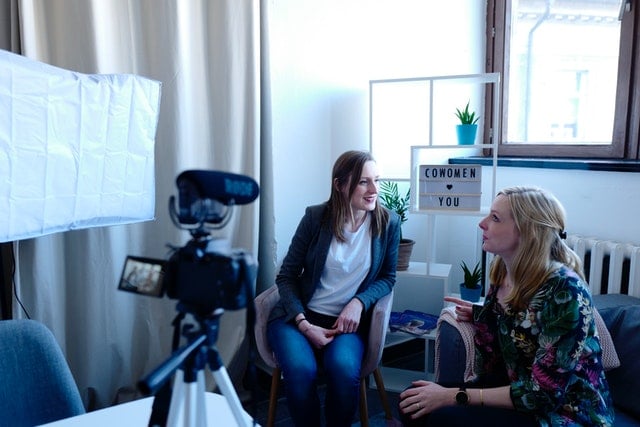Course Material (A Guide for Beginners + Online Teaching Tips)
Andrew Folkler
Updated by Tara Malone
When it comes to developing your course materials for your online course, where should you start? Should you do an entire video series or type out detailed essays? Are worksheets necessary?
Your course materials are a core part of the online course business. Your students will rely on your lessons to learn a valuable skill to achieve a specific transformation. And with your guidance, your students will get there.
So how do you plan out your course material so your students get the best possible learning experience?
In this article, you will learn the different types of course material, how to present it effectively, and how you can create your course material today.
Let’s dig in!

Types of Course Material
People learn in different ways based on their senses and their cultural upbringing. You may have heard about the VARK learning modal. Popularized by Fleming and Mills in 1992, it’s based on the idea that people have four primary learning styles: visual, aural, reading/writing, and kinesthetic.
Visual learners rely on seeing something to learn, while auditory learners retain information better through listening. Readers, of course, learn best through reading and writing about the material. And lastly, kinesthetic learners are people who understand through the act of performing an activity.
Now you might worry and think, “How do I create course material that caters to all these different learning styles?”
Fortunately, most common practices already incorporate these four modalities of learning. Even though everyone might have a preferred learning style, they still learn better by combining these styles. Combining the learning modalities creates a much more immersive learning experience where you can maximize the retention of information. This is why you will retain more information if you read a book while simultaneously listening to the audiobook format.
Varying your course material will also benefit your students as it keeps them from bored. Here are some different types of course materials that you can create:
- Photos (Visual)
- Articles (Visual, Reading)
- Ebooks/PDFs (Visual, Reading)
- Podcasts/Mp3s (Aural, Kinesthetic)
- Diagrams (Visual, Reading)
- Videos w/subtitles (Visual, Aural, Reading)
- Course Documents (Visual, Reading, Kinesthetic)
- Worksheets (Visual, Reading, Kinesthetic)
- Apps/Programs (Visual, Aural, Reading, Kinesthetic)
- Quizzes/Exams (Visual, Aural, Reading, Kinesthetic)
- Web Pages (Visual, Aural, Reading, Kinesthetic)
Presenting Course Material Effectively

Now that you know the different teaching modalities, you might be wondering exactly how to present your lessons effectively to your students.
Here are five teaching tips for presenting your course material.
Tip #1 – Don’t Make Assumptions About What Your Learners Know
To know your students’ level of understanding, you need to conduct thorough research on your target audience. Knowing your target audience will help you identify which concepts your students struggle with and which ones they have a firm grasp on.
As a subject matter expert, it can be easy to forget that not everyone knows the basics. Keep in mind that at one point, even you started with no prior knowledge in your field. Be sure to emphasize fundamentals and build upon them in your course materials.
Tip #2 – Set Learning goals and Objectives in Advance
Before creating your course materials, you will need to identify what transformation the student will receive after completing your program. Will your program help them in their relationships? Or grow their financial wealth? Perhaps your program will guide entrepreneurs in scaling their businesses.
Knowing the learning goals and objectives in advance helps you distill your course materials to only the lessons they need to achieve the transformation. You can trim the fluff and include only the core components in your lesson plan.
Tip #3 – Clearly Define New Terms and Concepts to Build a Foundation
Great course materials lay a solid foundation for your students so they will be able to comprehend the more advanced concepts. Ensure that you define new terms and concepts clearly as you create your lessons.
A great technique to ask yourself is, “If I showed this to a 5th-grade student (10-year-old), would they be able to understand it?”
The purpose of this technique is to help ensure you maximize your students’ retention of the information. You are breaking down the concepts into their most basic components so anyone can understand them.
Tip #4 – Limit the Number of Concepts in Each Lesson
What is the correct number of concepts per lesson? It might feel like a Goldilocks situation. Too many ideas would feel overwhelming and confusing, while too little feels elementary. Typically, you want to restrict your lessons to one to two concepts.
This is because you want your students to fully digest each idea before moving on to the next one. Keeping your concepts down to one or two per lesson helps you go into greater detail. You can explain different scenarios and provide detailed examples to elaborate on that concept.
Tip #5 – Test Your Students’ Understanding Regularly
You must know your students’ progress and understanding as a course creator. Otherwise, you won’t be able to effectively give them the transformation they are looking for. Students might get confused with specific concepts. In addition, you want to ensure that you are holding your students accountable.
There are a few ways you can test your student’s understanding. You could use
- Homework and assignments
- Exams and quizzes
- 1 on 1 calls
- Group accountability calls
- Live Q&A calls
Remember, grades are not the focus. You want to ensure that your students learn and apply the concepts you teach. Some students might have test anxiety and may not perform well in exams. You must stress the importance of learning over scoring high grades.
When you test your students’ understanding, you can identify areas where they are struggling. This data can help you improve your course materials in the future as you may need to explain a complex concept further.
How to Create Your Course Material

Creating your course material doesn’t have to be daunting. It is actually a lot of fun! This is your chance to teach your gift to your students and showcase your expertise in your field.
When creating your course materials, there are a few best practices to keep in mind to produce industry-standard learning materials for your students.
Create Professional Video Content
Video content is one of the most popular mediums to teach your students. Not only does it engage them visually and auditorily, but it also allows you to explain complex concepts in detail.
You will need good lighting and a quality microphone when creating video content. Nothing aggravates your viewers more than a video where you are not visible or audible. Good lighting will help you look professional and authentic. Clear audio helps make your video easy to listen to and coherent.
Ensure you prepare your material ahead of time to minimize filler words and stuttering. You can also edit your video after recording to remove any bad takes.
If you can get a transcription, you can include subtitles to engage the reading part of your viewer’s brains when they are viewing your video.
Develop Engaging Online Presentations
Another essential principle is to be engaging when you are presenting. You don’t want to be putting your students to sleep, right? Fortunately, you can employ a few techniques to deliver engaging online presentations.
First, use the power of storytelling. When you tell a story, you immediately grab your listeners’ attention. The listener will empathize with your characters and want to know how the story ends. Storytelling is a fantastic medium to convey a key message or concept to your audience. If you’re going to hammer down a core fundamental principle, tie it in with a story.
Another essential technique is to stay on topic. It can be easy to go down a rabbit hole or go off on tangents. However, this is more likely to confuse your audience than enrich their learning. Prepare your presentation material ahead of time so you will stay on topic during your presentation.
The last technique you can use is to include visual aids in your presentation. Visual aids allow you to emphasize your main ideas with diagrams, key definitions, and bullet points. Viewers can take notes, engaging their kinesthetic learning as they listen to your presentation.
Design Handouts and Supplemental Resources
When you are designing your course materials, be sure to include additional resources for your students. Handouts and supplemental materials can help a student recall key information. Here are some potential resources you could give your students:
- How-to guides
- Cheat sheets
- Fill in the blank worksheets
- Sample exam questions
- Homework assignments
- Articles
- Podcast episodes
- Ebooks
When designing your supplemental learning material, remember that quality trumps quantity. Your students are not paying you for a high amount of content and learning material. Instead, they are paying for the transformation that your class will bring them. Therefore, it is imperative that your primary focus as you are developing your course materials is to ensure that quality is your priority.
Ready to Create Your Course Material?
Armed with this information, it’s time to start developing your own engaging course materials.
But creating amazing course material is not enough to profit from online courses anymore. That’s because content on its own is cheap these days, especially with the rise of AI tools like ChatGPT. This means that people are only willing to pay premium prices for courses that are built on actual expertise and deliver real transformation.
At Mirasee, we refer to courses that meet this criteria as hybrid courses, and we have developed a method for creating life-changing courses that sell for a premium price. On top of this, we’ve also devised a way to leverage ChatGPT to carry out the bulk of the research, content creation, and copywriting for you.
What’s more, we’ve designed a free Bootcamp to help course creators get up-to-speed on hybrid course principles. If you’d like to learn more about the process of developing profitable hybrid courses, we invite you to join our Hybrid Courses Bootcamp.
Let’s Start Building Your Online Course!
In our FREE Hybrid Courses Bootcamp, we’ll walk you through how to transform your knowledge and expertise into a profitable online course… one your students will love.